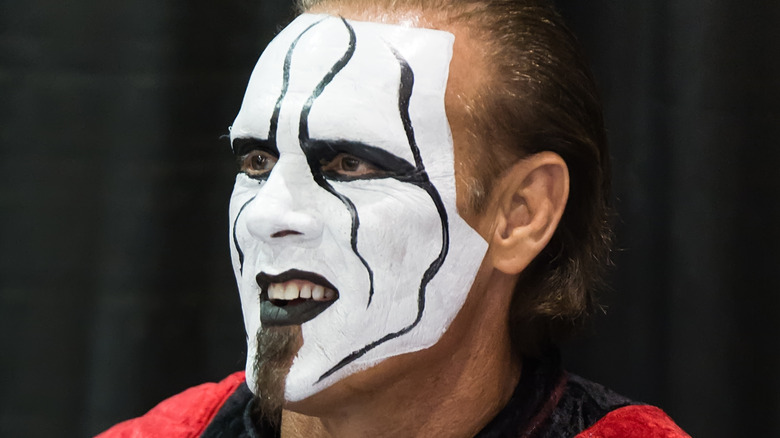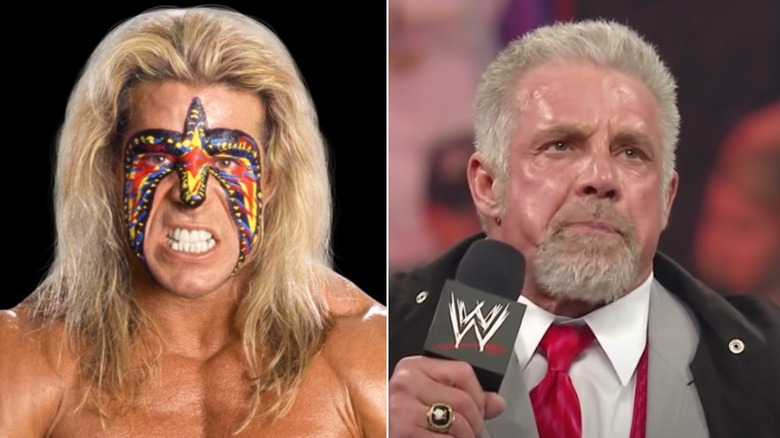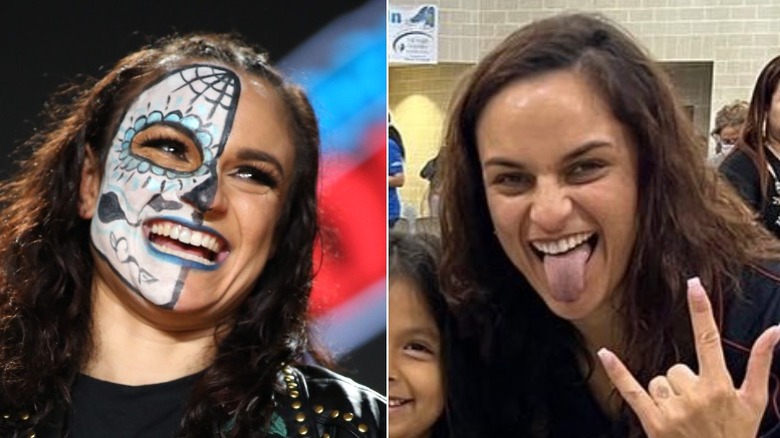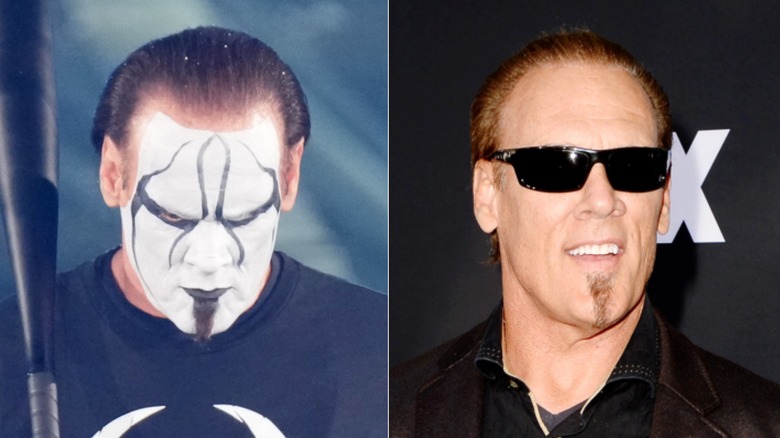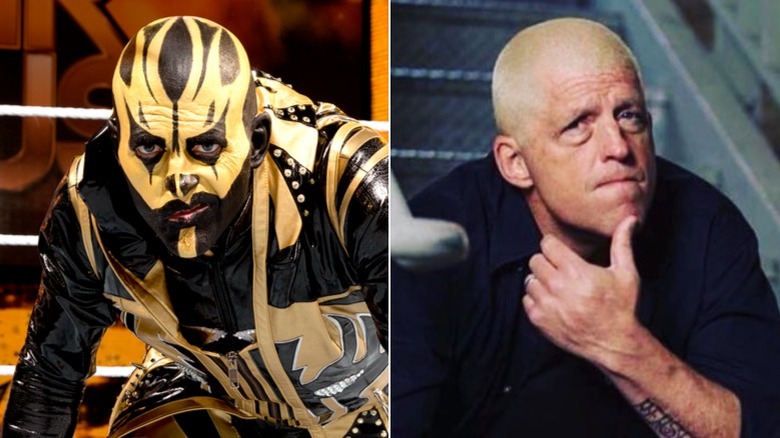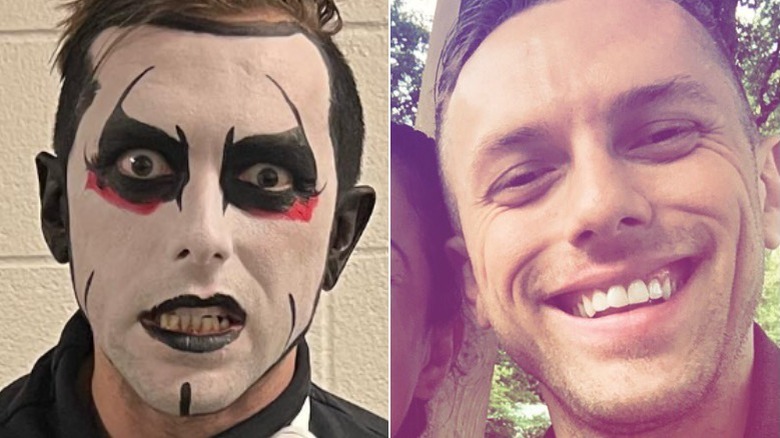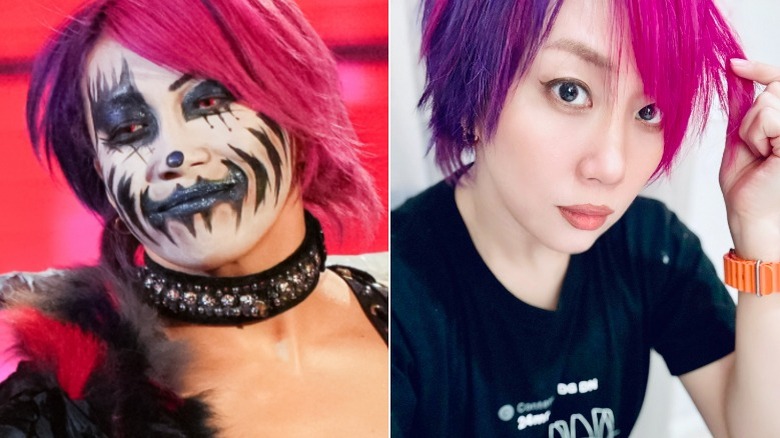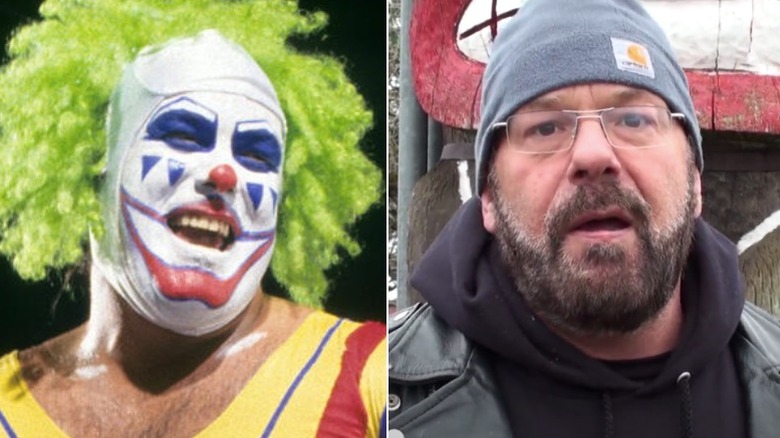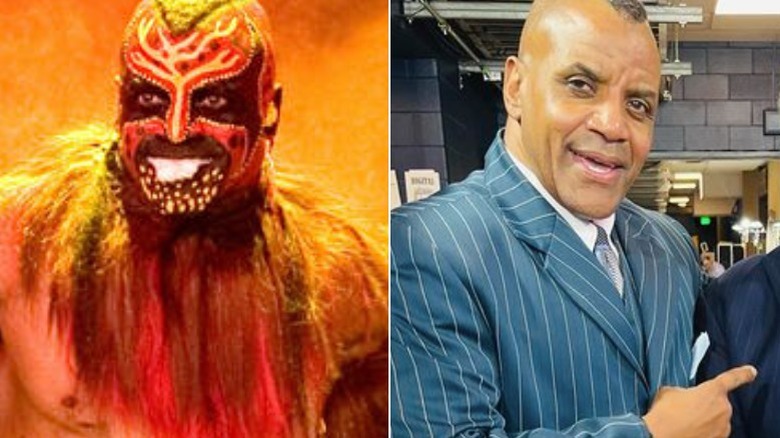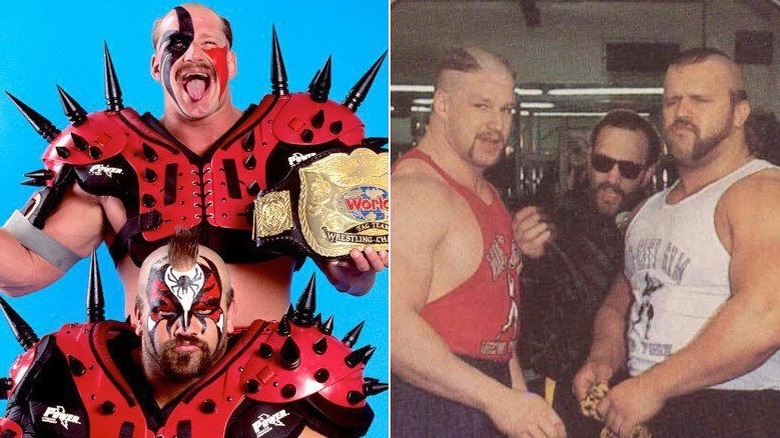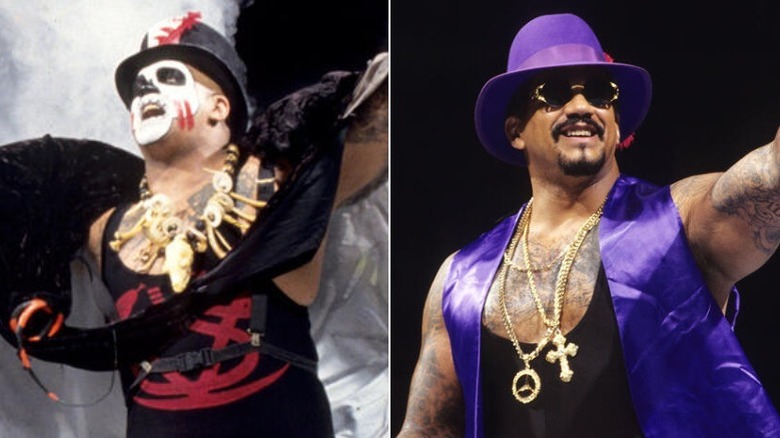Wrestlers You Would Never Recognize Without Makeup
Pro wrestlers' character gimmicks are many and varied, and even some of the most famous and recognizable wrestling icons might not look anything like they used to by the time they hit the big time. To maximize their visual impact, some fashion themselves as all-American heroes, or attempt to elicit hostile reactions with their ring gear. Others go all in on flamboyant entrances, while others still wear a cool mask.
The wrestlers on this list have all opted for what just might be one of the most labor-intensive ways to make a visual impact: makeup. A cool face paint design might be a handful to apply before a show — let alone on a regular basis — but it's a potentially great way to stand out in the ring. However, since this means the audience learns to associate the wrestlers with the makeup they wear, it may be difficult to recognize them outside the ring. Here's a look at some of the best-known professional wrestlers who use makeup, and how unrecognizable they are without it.
The Ultimate Warrior
In the late 1980s and the early 1990s, the Ultimate Warrior was precisely what it said on the proverbial name tag. A fierce and barbaric powerhouse made of hulking muscles and roaring energy, he tore through his opponents in the World Wrestling Federation like there's no tomorrow. In 1990, he even beat none other than Hulk Hogan at Wrestlemania VI, and his ensuing run as the WWF champion lasted nearly 300 days. Without his ever-changing face paint designs, Warrior looked much more like a regular guy than his character, who famously hailed from "Parts Unknown." This made the powerhouse potentially difficult to recognize, especially when he complemented his civilian look with a shorter haircut and a thick goatee.
Whether he was hoisting his enemies over his head in the ring while rocking his iconic face paint or otherwise taking care of things, Warrior's life was just as interesting. In the ring, his changed appearance at 1992's Wrestlemania VIII launched rumors that there were two different Ultimate Warriors. Outside it, the man admitted to misusing steroids and had a habit of clashing with WWF/E boss Vince McMahon. The wrestler born Jim Hellwig even changed his name to Warrior — just the word Warrior — in 1993 to get an edge over McMahon during a legal dispute.
On April 8, 2014, Warrior passed away at the age of 54. Faithful to his larger-than-life nature, he was inducted into the WWE Hall of Fame just days earlier.
Thunder Rosa
Melissa Cervantes, who's known in wrestling as Thunder Rosa, has been working in various federations since her debut in 2014 and is arguably best known for her title-winning tenure with All Elite Wrestling, where she has plied her trade since 2021. As Thunder Rosa's hardcore fans know, the performer also known as "La Mera Mera" has a résumé that goes far above and beyond professional wrestling. Not only was she once was an MMA fighter, she also holds a bachelor's degree in Sociology and has been a social worker, which is something so important to her that even her catchy ring name stems from her old workplace, Thunder Road, where she helped teens and young adults with serious problems. She's done so much in her life that she only got into wrestling at a relatively late age of 27, but anyone who's seen her knows this hasn't exactly slowed her down.
Apart from her energetic in-ring style, "La Mera Mera" is known for the eye-popping variations of intricate Día de los Muertos style skull makeup she wears while on the job. However, she's not one of those pro wrestlers who protect their true identity by any means necessary. As such, fans who are used to the skull designs might be looking at an adjustment period if they check out her social media, where she often posts images of herself without the face paint. She has also experimented with a glitzier makeup design that doesn't cover so much of her face.
Sting
Sting is an icon of pro wrestling, and he's experimented with a few looks over the years. His first popular makeup-wearing character was an extremely 1980s, surfer-style figure who was all about neon-tinted clothes, and wore a face paint that was similar to the designs the Ultimate Warrior used. However, he eventually transitioned to a black-and-white full-face makeup that somewhat resembled Brandon Lee's character in the film "The Crow." Since then, he's worn variations of the monochromatic face paint, slightly altering it as situation and gimmicks require — at one time even adding a red-smudged grin to portray a "Joker Sting."
Despite the fact that it's very easy to associate Sting's iconic look with "The Crow," the wrestler himself has told Bleacher Report that he was trying to figure out a new character, and his colleague — tragic wrestler Scott Hall — came up with the idea for the new makeup and clothes.
"I thought my character had to change before fans started sticking their finger down their throat," Sting said. "I was trying to figure out what to do and Hall says, 'You know what you should do? Get a trench coat, man. Paint your face white. Put some black around your eyes. Something mysterious. That's what I would do, man.' I ended up painting my face and it evolved into what it evolved into. It didn't really have anything to do with 'The Crow' at first but there were some similarities, I admit."
Goldust
When Goldust emerged in 1995, his full-head face paint and gold and black color scheme were a unique visual, and they went on to be even more unique once the Attitude Era started and wrestlers who preferred a somewhat more muted look — like Stone Cold Steve Austin and the Rock – started dominating the squared circle. Even after joining AEW, where he wrestles using his own name, Dustin Rhodes hasn't completely abandoned the face paint. Instead, he prefers a half-face makeup that has a vaguely demonic theme.
Of course, Rhodes doesn't wear the face paint during his off hours. Along with fellow wrestler Cody Rhodes, who once portrayed his equally made-up tag team partner Stardust, he's the son of WWE Hall of Famer Dustin Rhodes... and if you've caught a glimpse of him without his signature makeup design, the family resemblance is clear.
The flamboyant character might have been hard to portray for many wrestlers, but Rhodes not only made it his own — as the son of an industry legend, he also used Goldust to carve his own path in the business. "I am Dusty's son, but I learned the hard way I was never going to be 'The American Dream.' That was difficult for me, and I made some molehills into mountains," Rhodes said in an interview with Sports Illustrated. " Before Dad passed, we talked so much about the Goldust character, what it grew into, and how much he was proud of it."
Danhausen
As Danhausen's AEW entrance theme reminds the viewers ad infinitum, the wrestler is very nice and very evil. A fast-talking, squeaky-voiced, mildly nervous-looking cartoon villain with stylized demon-meets-vampire makeup, he cuts a memorable figure. Thanks to his clever B-movie horror vibe and an inherently likable persona, he also moves a considerable amount of merchandise, especially for a wrestler who's not historically a regular big-time main eventer. Much of this is because he found an untapped niché and turned out to be the perfect guy for it.
"I was just a bearded guy with the tattoos, trying to be a tough guy, and I'm not a tough guy naturally," Danhausen told The New York Times. "But I can be weird and charismatic, goofy. That's easy. That's also a role that most people don't want to fill."
Danhausen seems like a perfectly constructed character right down to the moniker, but the performer's very real name predetermined that part of the package. Behind the face paint, mannerisms, and fun promos is Donovan Danhausen, who's found a perfect way to combine his passions of wrestling, horror, and comedy under a single umbrella with the Danhausen gimmick. The success wasn't immediate. He first labored in the indies without makeup, calling himself Kid Gorgeous. When he eventually sat down and started crafting the face-painted figure that would become Danhausen, he initially experimented with a straight-up horror monster before the comedy that made the gimmick famous crept in via audience response.
Asuka
From her multi-colored hair to her elaborate makeup designs, contact lenses, in-ring and entrance gear, and even facial expressions, Asuka happily uses every trick in the book when it comes to making her matches as eye-popping as possible ... even though she might not even need to, seeing as she's one of the more technically proficient wrestlers in the WWE. This isn't exactly surprising though, considering that Asuka, whose real name is Kanako Urai, worked as a graphic designer before embarking on a more athletic career.
For wrestling fans, Asuka is known for her in-ring prowess and a seemingly neverending array of face paint designs that range from simple horizontal stripes to fleshy, exaggerated horror creations. However, outside the ring, the Empress of Tomorrow quite understandably rocks a more casual look, with her signature pink and purple hair the only reminder of her flamboyant ring attire.
That look may be more familiar to the people who follow her "Kana Chan TV" YouTube channel, named after Kana, the ring name she used for 11 years as a top star in Japan. This is something she has patiently — and successfully — worked to be in the U.S., too, though her mission in WWE goes beyond personal glory. "I wanted to change women's wrestling in WWE," Asuka told Newsweek. "In wrestling, men and women do the same thing, but sometimes the men look more powerful and more impressive. I am trying my best to fill the gap between men and women."
Doink the Clown
Whenever wrestling fans talk about the unholy union of grease paint and the squared circle, it's no huge shock if the name Doink the Clown comes up. Like the fear of clowns, coulrophobia, made flesh, this circus-themed menace used every nightmarish trick in the book as a full-on heel character before eventually transitioning into a more friendly role.
Doink's heavy makeup and costume lent themselves to all sorts of clownish shenanigans, up to and including two identical Doinks attacking an opponent. Because of this, several different wrestlers have taken up the mantle over the years, either on a long-term basis or as a one-off stunt — in fact, there's a chance you didn't know Chris Jericho has a night as a Doink the Clown in his stacked résumé.
Despite the character's malleability and the many feet that have occupied his clown boots, wrestler Matthew "Matt Borne" Osborne is generally considered to be the single best Doink out there, since he was the first man to perform as the character and embodied Doink like none other. As you can probably guess, Osborne — who died in 2013 at 55 years old — looks nothing like the character in person. During his years in various wrestling promotions, he also wrestled under the Matt Borne moniker, used a lumberjack gimmick called Big Josh, and even briefly experimented with a deconstructed, deteriorating Doink figure he called Borne Again.
Boogeyman
The Boogeyman is, without doubt, one of the strangest gimmicks the WWE has ever come up with. In 2005, he was introduced as an actor from a fictional TV show who had embodied his character way too thoroughly. According to kayfabe, the network sent him to haunt WWE because they couldn't figure out what to do with a hulking guy who was method-acting a fairytale monster, wore black and red face paint, and had a penchant for smashing large clocks over his head. Though the actor aspect of the character eventually disappeared from the Boogeyman's backstory, his backstage antics, peculiar mannerisms, and signature habit of eating worms — and forcefully offering them to others — remained.
The memorable character was portrayed by Marty Wright, who first attempted to enter the WWE's "Tough Enough" competition at 40 years old by lying about his age. After they found out and cut him, he made enough noise to convince people to give him a chance anyway — which eventually led to the Boogeyman.
In an interview with the "Wrestling Reality" podcast (via Bleacher Report), Wright revealed he was completely OK with the character's outlandish antics. In fact, he pushed for an even more shocking portrayal that would have shown the Boogeyman eating all sorts of other insects with the worms. However, the business side of things came in the way. "We had to pay an infestation clause, which would cost much more money," Wright said. "Worms were the only thing we could control."
The Road Warriors
The Road Warriors, aka the Legion of Doom, may be the most dominant duo in the history of tag team wrestling, running roughshod wherever they went. Comprised of WWE Hall of Famers Road Warrior Animal (Joseph Laurinaitis) and Road Warrior Hawk (Michael Hegstrand), the team's face-painted, mohawk-wearing, spiky shoulder pad aesthetic was heavily reminiscent of the character Wez (Vernon Wells) in "Mad Max: The Road Warrior."
Animal and Hawk made their name in various promotions during the 1980s, and saw more success working for the WWF during the 1990s. Unfortunately, the 2000s were less kind to the brutal team. Hawk struggled with addiction — a situation that the WWE infamously riffed on in one Attitude Era storyline that hit too close to home. Hegstrand ultimately passed away in 2003, at just 45 years old. Laurinaitis continued to wrestle after his long-time partner was gone, but like so many other professional wrestlers who have passed away, he also died relatively young — at age 60 in 2020.
The Road Warriors were so respected that A-lister Dwayne Johnson paid homage after Laurinaitis' death. "When I was making my bones, still learning the business in the WWE as a very young 'The Rock' – I wrestled these guys so many times on the road and they always took good care of me and made sure I learned. Tough as nails. Good men. Greatest tag team of all time," he wrote on Instagram.
If you or anyone you know needs help with addiction issues, help is available. Visit the Substance Abuse and Mental Health Services Administration website or contact SAMHSA's National Helpline at 1-800-662-HELP (4357).
Papa Shango
Sometimes, the characters that a wrestler portrays over the course of their career are so radically different from each other that the man behind the gimmick is borderline unrecognizable — for instance, WWE star Glen Jacobs had to portray a wrestling Christmas tree and a villainous dentist before the masked monster Kane. Charles Wright's gimmick journey is nearly as strange, as he gained attention as two different high-profile figures ... neither of which would probably go over particularly well today.
In 1992, Wright debuted as Papa Shango, a voodoo priest stereotype with skull-themed face paint who terrorized some of the company's top stars. After the character disappeared, Wright eventually reemerged sans makeup as the Godfather, a smiling pimp figure who wore colorful clothes and was constantly accompanied by several women. This turned out to be Wright's defining gimmick, earning him a place in the WWE Hall of Fame.
If Papa Shango feels familiar, Wright told Film Hounds that the gimmick drew heavily from Baron Samedi (Geoffrey Holder), a James Bond villain from "Live and Let Die." He also said that the character was custom-designed to freak out the children in the audience. "I had told Vince, 'Let me do something different, let me go after kids,' and I was scaring kids on TV," Wright said. "I was telling kids, 'You know, when you go to sleep tonight, you won't dream of the ocean, you'll dream of death! You'll dream of Papa Shango!'"
